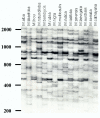Genetic diversity and relationships in mulberry (genus Morus) as revealed by RAPD and ISSR marker assays
- PMID: 14715088
- PMCID: PMC343270
- DOI: 10.1186/1471-2156-5-1
Genetic diversity and relationships in mulberry (genus Morus) as revealed by RAPD and ISSR marker assays
Abstract
Background: The genus Morus, known as mulberry, is a dioecious and cross-pollinating plant that is the sole food for the domesticated silkworm, Bombyx mori. Traditional methods using morphological traits for classification are largely unsuccessful in establishing the diversity and relationships among different mulberry species because of environmental influence on traits of interest. As a more robust alternative, PCR based marker assays including RAPD and ISSR were employed to study the genetic diversity and interrelationships among twelve domesticated and three wild mulberry species.
Results: RAPD analysis using 19 random primers generated 128 discrete markers ranging from 500-3000 bp in size. One-hundred-nineteen of these were polymorphic (92%), with an average of 6.26 markers per primer. Among these were a few putative species-specific amplification products which could be useful for germplasm classification and introgression studies. The ISSR analysis employed six anchored primers, 4 of which generated 93 polymorphic markers with an average of 23.25 markers per primer. Cluster analysis of RAPD and ISSR data using the WINBOOT package to calculate the Dice coefficient resulted into two clusters, one comprising polyploid wild species and the other with domesticated (mostly diploid) species.
Conclusion: These results suggest that RAPD and ISSR markers are useful for mulberry genetic diversity analysis and germplasm characterization, and that putative species-specific markers may be obtained which can be converted to SCARs after further studies.
Figures



Similar articles
-
Single primer amplification reaction methods reveal exotic and indigenous mulberry varieties are similarly diverse.J Biosci. 2005 Dec;30(5):669-77. doi: 10.1007/BF02703567. J Biosci. 2005. PMID: 16388141
-
Construction of fingerprinting and genetic diversity of mulberry cultivars in China by ISSR markers.Yi Chuan Xue Bao. 2006 Sep;33(9):851-60. doi: 10.1016/S0379-4172(06)60119-4. Yi Chuan Xue Bao. 2006. PMID: 16980132
-
Molecular characterization of mulberry (Morus spp.) genotypes via RAPD and ISSR.J Sci Food Agric. 2012 Jun;92(8):1633-7. doi: 10.1002/jsfa.4749. Epub 2011 Dec 20. J Sci Food Agric. 2012. PMID: 22222844
-
Mulberry (Morus spp.) has the features to treat as a potential perennial model system.Plant Signal Behav. 2018;13(8):e1491267. doi: 10.1080/15592324.2018.1491267. Epub 2018 Jul 26. Plant Signal Behav. 2018. PMID: 30047827 Free PMC article. Review.
-
The advent of genomics in mulberry and perspectives for productivity enhancement.Plant Cell Rep. 2011 May;30(5):825-38. doi: 10.1007/s00299-011-1059-1. Epub 2011 Mar 23. Plant Cell Rep. 2011. PMID: 21431349 Review.
Cited by
-
Estimating Genetic Conformism of Korean Mulberry Cultivars Using Random Amplified Polymorphic DNA and Inter-Simple Sequence Repeat Profiling.Plants (Basel). 2018 Mar 15;7(1):21. doi: 10.3390/plants7010021. Plants (Basel). 2018. PMID: 29543756 Free PMC article.
-
On the origin of Solanum nigrum: can networks help?Mol Biol Rep. 2011 Feb;38(2):1171-85. doi: 10.1007/s11033-010-0215-y. Epub 2010 Jun 24. Mol Biol Rep. 2011. PMID: 20574711
-
Genome size, genetic diversity, and phenotypic variability imply the effect of genetic variation instead of ploidy on trait plasticity in the cross-pollinated tree species of mulberry.PLoS One. 2023 Aug 11;18(8):e0289766. doi: 10.1371/journal.pone.0289766. eCollection 2023. PLoS One. 2023. PMID: 37566619 Free PMC article.
-
Metabolomic Analysis of Morus Cultivar Root Extracts and Their Ameliorative Effect on Testosterone-Induced Prostate Enlargement in Sprague-Dawley Rats.Int J Mol Sci. 2020 Feb 20;21(4):1435. doi: 10.3390/ijms21041435. Int J Mol Sci. 2020. PMID: 32093293 Free PMC article.
-
Relationship between metabolic and genomic diversity in sesame (Sesamum indicum L.).BMC Genomics. 2008 May 29;9:250. doi: 10.1186/1471-2164-9-250. BMC Genomics. 2008. PMID: 18510719 Free PMC article.
References
-
- Hou YJ. Mulberry breeding. Sericulture Department, Zhejiang Agriculture University, Hangzhou, China. 1994. p. 4.
-
- Linnaeus C. Species Plantarum. Vol. 2. Stockholm; 1753. p. 986.
-
- Koidzumi G. Taxonomical discussion on Morus plants. Bull Imp Sericult Exp Stat. 1917;3:1–62.
-
- Koidzumi G. Synopsis specierum generis Mori. Bull Imp Sericult Exp Stat. 1923;11:1–50.
-
- Hotta T. Taxonomical studies on the Morus plants and their distributions in Japan and its viscinties. Japanese Society for Promotion of Science, Ueno Park, Tokyo. 1958. pp. 1–161.
Publication types
MeSH terms
Substances
LinkOut - more resources
Full Text Sources
Research Materials

